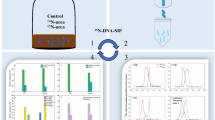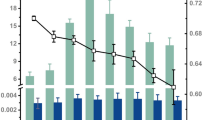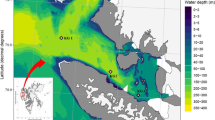Abstract
Change of bacterial community occurring along a hot water stream in the Hishikari gold mine, Japan, was investigated by applying a combination of various culture-independent techniques. The stream, which is derived from a subsurface anaerobic aquifer containing plentiful CO2, CH4, H2, and NH +4 , emerges in a mine tunnel 320 m below the surface providing nutrients for a lush microbial community that extends to a distance of approximately 7 m in the absence of sunlight-irradiation. Over this distance, the temperature decreases from 69°C to 55°C, and the oxidation-reduction potential increases from −130 mV to +59 mV. In the hot upper reaches of the stream, the dominant phylotypes were: 1) a deeply branching lineage of thermophilic methane-oxidizing γ-Proteobacteria, and 2) a thermophilic hydrogen- and sulfur-oxidizing Sulfurihydrogenibium sp. In contrast, the prevailing phylotypes in the middle and lower parts of the stream were closely related to ammonia-oxidizing Nitrosomonas and nitrite-oxidizing Nitrospira spp.. Changes in the microbial metabolic potential estimated by competitive PCR analysis of genes encoding the enzymes, particulate methane monooxygenase (pmoA), ammonia monooxygenase (amoA), and putative nitrite oxidoreductase (norB), also substantiated the community shift indicated by 16S rRNA gene analysis. The diversity of putative norB lineages was assessed for the first time in the hot water environment. Estimation of dominant phylotypes by whole-cell fluorescent in situ hybridization and changes in inorganic nitrogen compounds such as decreasing ammonium and increasing nitrite and nitrate in the mat-interstitial water along the stream were consistent with the observed transition of the bacterial community structure in the stream.





Similar content being viewed by others
References
Alfreider A, Pernthaler J, Amann R, Sattler B, Glockner F, Wille A, Psenner R (1996) Community analysis of the bacterial assemblages in the winter cover and pelagic layers of a high mountain lake by in situ hybridization. Appl Environ Microbiol 62:2138–2144
Allen SE, Grimshaw HM, Parkinson JA, Quarmby C (1974) Inorganic constituents: nitrogen. In: Allen SE (ed) Chemical analysis of ecological materials. Blackwell Scientific Publications, London, pp 184–206
Bedard C, Knowles R (1989) Physiology, biochemistry, and specific inhibitors of CH4, NH +4 , and CO oxidation by methanotrophs and nitrifiers. Microbiol Rev 53:68–84
Bodrossy L, Kovács KL, McDonald IR, Murrell JC (1999) A novel thermophilic methane-oxidising γ-Proteobacterium. FEMS Microbiol Lett 170:335–341
Bruins ME, Janssen AE, Boom RM (2001) Thermozymes and their applications: a review of recent literature and patents. Appl Biochem Biotechnol 90:155–186
Cole JR, Chai B, Marsh TL, Farris RJ, Wang Q, Kulam SA, Chandra S, McGarrell DM, Schmidt TM, Garrity GM, Tiedje JM (2003) The Ribosomal Database Project (RDP-II): previewing a new autoaligner that allows regular updates and the new prokaryotic taxonomy. Nucleic Acids Res 31:442–443
Costello AM, Lidstrom ME (1999) Molecular characterization of functional and phylogenetic genes from natural populations of methanotrophs in lake sediments. Appl Environ Microbiol 65:5066–5074
Dionisi HM, Layton AC, Harms G, Gregory IR, Robinson KG, Sayler GS (2002) Quantification of Nitrosomonas oligotropha-like ammonia-oxidizing bacteria and Nitrospira spp from full-scale wastewater treatment plants by competitive PCR. Appl Environ Microbiol 68:245–253
Ehrich S, Behrens D, Lebedeva E, Ludwig W, Bock E (1995) A new obligately chemolithoautotrophic, nitrite-oxidizing bacterium, Nitrospira moscoviensis sp nov and its phylogenetic relationship. Arch Microbiol 164:16–23
Ferris MJ, Ward DM (1997) Seasonal distributions of dominant 16S rRNA-defined populations in a hot spring microbial mat examined by denaturing gradient gel electrophoresis. Appl Environ Microbiol 63:1375–1381
Hayashi NR, Ishida T, Yokota A, Kodama T, Igarashi Y (1999) Hydrogenophilus thermoluteolus gen nov, sp nov, a thermophilic, facultatively chemolithoautotrophic, hydrogen-oxidizing bacterium. Int J Syst Bacteriol 2:783–786
Hiraishi A, Umezawa T, Yamamoto H, Kato K, Maki Y (1999) Changes in quinone profiles of hot spring microbial mats with a thermal gradient. Appl Environ Microbiol 65:198–205
Hirota R, Yamagata A, Kato J, Kuroda A, Ikeda T, Takiguchi N, Ohtake H (2000) Physical map location of the multicopy genes coding for ammonia monooxygenase and hydroxylamine oxidoreductase in the ammonia-oxidizing bacterium Nitrosomonas sp strain ENI-11. J Bacteriol 182:825–828
Holmes AJ, Costello A, Lidstrom ME, Murrell JC (1995) Evidence that particulate methane monooxygenase and ammonia monooxygenase may be evolutionarily related. FEMS Microbiol Lett 132:203–208
Hommes NG, Sayavedra-Soto LA, Arp DJ (1998) Mutagenesis and expression of amo, which codes for ammonia monooxygenase in Nitrosomonas europaea. J Bacteriol 180:3353–3359
Hooper AB, Terry KR (1974) Photoinactivation of ammonia oxidation in Nitrosomonas. J Bacteriol 119:899–906
Huber H, Stetter KO (1998) Hyperthermophiles and their possible potential in biotechnology. J Biotechnol 64:39–52
Huber R, Huber H, Stetter KO (2000) Towards the ecology of hyperthermophiles: biotopes, new isolation strategies and novel metabolic properties. FEMS Microbiol Rev 24:615–623
Hugenholtz P, Pitulle C, Hershberger KL, Pace NR (1998) Novel division level bacterial diversity in a Yellowstone hot spring. J Bacteriol 180:366–376
Inagaki F, Takai K, Hirayama H, Yamato Y, Nealson KH, Horikoshi K (2003) Distribution and phylogenetic diversity of the subsurface microbial community in a Japanese epithermal gold mine. Extremophiles 7:307–317
Izawa E, Urashima Y, Ibaraki K, Suzuki R, Yokoyama T, Kawasaki K, Koga A, Taguchi S (1990) The Hishikari gold deposit: high-grade epithermal veins in Quaternary volcanics of southern Kyushu, Japan. J Geochem Explor 36:1–56
Kieft TL, Fredrickson JK, Onstott TC, Gorby YA, Kostandarithes HM, Bailey TJ, Kennedy DW, Li SW, Plymale AE, Spadoni CM, Gray MS (1999) Dissimilatory reduction of Fe (III) and other electron acceptors by a Thermus isolate. Appl Environ Microbiol 65:1214–1221
Kirstein K, Bock E (1993) Close genetic relationship between Nitrobacter hamburgensis nitrite oxidoreductase and Escherichia coli nitrate reductases. Arch Microbiol 160:447–453
Kurosawa N, Itoh YH, Iwai T, Sugai A, Uda I, Kimura N, Horiuchi T, Itoh T (1998) Sulfurisphaera ohwakuensis gen nov, sp nov, a novel extremely thermophilic acidophile of the order Sulfolobales. Int J Syst Bacteriol 2:451–456
Lane DJ (1991) 16S/23S sequencing. In: Stackebrandt E, Goodfellow M (eds) Nucleic acid techniques in bacterial systematics. John Wiley & Sons, New York, pp 115–175
Manz W, Szewzyk U, Ericsson P, Amann R, Schleifer KH, Stenstrom TA (1993) In situ identification of bacteria in drinking water and adjoining biofilms by hybridization with 16S and 23S rRNA-directed fluorescent oligonucleotide probes. Appl Environ Microbiol 59:2293–2298
Marteinsson VT, Hauksdóttir S, Hobel CFV, Kristmannsdóttir H, Hreggvidsson GO, Kristjánsson JK (2001) Phylogenetic diversity analysis of subterranean hot springs in Iceland. Appl Environ Microbiol 67:4242–4248
McTavish H, Fuchs JA, Hooper AB (1993) Sequence of the gene coding for ammonia monooxygenase in Nitrosomonas europaea. J Bacteriol 175:2436–2444
Norton JM, Alzerreca JJ, Suwa Y, Klotz MG (2002) Diversity of ammonia monooxygenase operon in autotrophic ammonia-oxidizing bacteria. Arch Microbiol 177:139–149
Purkhold U, Pommerening-Röser A, Juretschko S, Schmid MC, Koops H-P, Wagner M (2000) Phylogeny of all recognized species of ammonia oxidizers based on comparative 16S rRNA and amoA Sequence analysis: implications for molecular diversity surveys. Appl Environ Microbiol 66:5368–5382
Reysenbach AL, Wickham GS, Pace NR (1994) Phylogenetic analysis of the hyperthermophilic pink filament community in Octopus Spring, Yellowstone National Park. Appl Environ Microbiol 60:2113–2119
Reysenbach AL, Ehringer M, Hershberger K (2000) Microbial diversity at 83°C in calcite springs, Yellowstone National Park: another environment where the Aquificales and “Korarchaeota” coexist. Extremophiles 4:61–67
Ruff-Roberts AL, Kuenen JG, Ward DM (1994) Distribution of cultivated and uncultivated cyanobacteria and Chloroflexus-like bacteria in hot spring microbial mats. Appl Environ Microbiol 60:697–704
Schramm A, de Beer D, Wagner M, Amann R (1998) Identification and activities in situ of Nitrosospira and Nitrospira spp. as dominant populations in a nitrifying fluidized bed reactor. Appl Environ Microbiol 64:3480–3485
Semrau JD, Chistoserdov A, Lebron J, Costello A, Davagnino J, Kenna E, Holmes AJ, Finch R, Murrell JC, Lidstrom ME (1995) Particulate methane monooxygenase genes in methanotrophs. J Bacteriol 177:3071–3079
Shears JH, Wood PM (1985) Spectroscopic evidence for a photosensitive oxygenated state of ammonia mono-oxygenase. Biochem J 226:499–507
Skirnisdottir S, Hreggvidsson GO, Hjörleifsdottir S, Marteinsson VT, Petursdottir SK, Holst O, Kristjansson JK (2000) Influence of sulfide and temperature on species composition and community structure of hot spring microbial mats. Appl Environ Microbiol 66:2835–2841
Stetter KO (1999) Extremophiles and their adaptation to hot environments. FEBS Lett 452:22–25
Stolyar S, Costello AM, Peeples TL, Lidstrom ME (1999) Role of multiple gene copies in particulate methane monooxygenase activity in the methane-oxidizing bacterium Methylococcus capsulatus Bath. Microbiology 145:1235–1244
Takacs CD, Ehringer M, Favre R, Cermola M, Eggertsson G, Palsdottir A, Reysenbach AL (2001) Phylogenetic characterization of the blue filamentous bacterial community from an Icelandic geothermal spring. FEMS Microbiol Ecol 35:123–128
Takai K, Komatsu T, Horikoshi K (2001) Hydrogenobacter subterraneus sp nov, an extremely thermophilic, heterotrophic bacterium unable to grow on hydrogen gas, from deep subsurface geothermal water. Int J Syst Evol Microbiol 51:1425–1435
Takai K, Hirayama H, Sakihama Y, Inagaki F, Yamato Y, Horikoshi K (2002) Isolation and metabolic characteristics of previously uncultured members of the order Aquificales in a subsurface gold mine. Appl Environ Microbiol 68:3046–3054
Takai K, Kobayashi H, Nealson KH, Horikoshi K (2003) Sulfurihydrogenibium subterraneum gen nov, sp nov, from a subsurface hot aquifer. Int J Syst Evol Microbiol 53:823–827
Ward DM, Ferris MJ, Nold SC, Bateson MM (1998) A natural view of microbial biodiversity within hot spring cyanobacterial mat communities. Microbiol Mol Biol Rev 62:1353–1370
Weller R, Bateson MM, Heimbuch BK, Kopczynski ED, Ward DM (1992) Uncultivated cyanobacteria, Chloroflexus-like inhabitants, and spirochete-like inhabitants of a hot spring microbial mat. Appl Environ Microbiol 58:3964–3969
Yamamoto H, Hiraishi A, Kato K, Chiura HX, Maki Y, and Shimizu A (1998) Phylogenetic evidence for the existence of novel thermophilic bacteria in hot spring sulfur-turf microbial mats in Japan. Appl Environ Microbiol 64:1680–1687
Acknowledgments
We are grateful to the management of the Sumitomo Metal Mining Co. Ltd. for its cooperation in and understanding of our research.
Author information
Authors and Affiliations
Corresponding author
Additional information
Communicated by W.D. Grant
Rights and permissions
About this article
Cite this article
Hirayama, H., Takai, K., Inagaki, F. et al. Bacterial community shift along a subsurface geothermal water stream in a Japanese gold mine. Extremophiles 9, 169–184 (2005). https://doi.org/10.1007/s00792-005-0433-8
Received:
Accepted:
Published:
Issue Date:
DOI: https://doi.org/10.1007/s00792-005-0433-8




